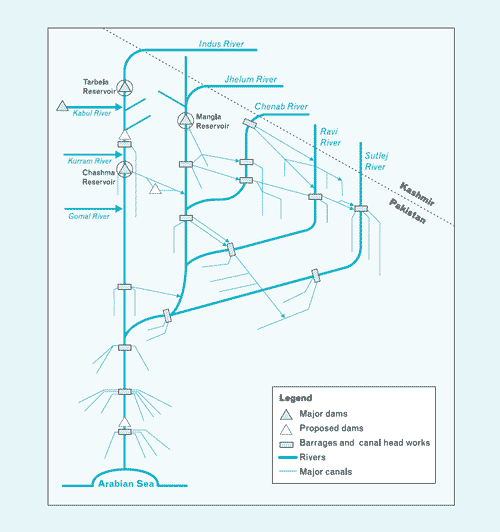 |
Agha Ali Akram advocates demand management for optimal adaptation to trends in water resources in the Indus Basin resulting from climate change. |
| The author is a graduate student at the Yale School of Forestry and Environmental Studies, United States of America, pursuing a PhD in environmental economics. | |
The Indus Basin is a very developed watershed, with considerable physical infrastructure and many users who depend on its hydrological cycles and balances. Amongst the users, the irrigation system is the largest one and in many ways the most complex and significant. Pakistan’s agriculture largely depends on it.
The near future will see the hydrological balance of the Indus Basin shift as the global climate changes. Current predictions indicate that the Indus Basin will become "flashier" with a wetter wet season and a drier dry season, along with a reduction in the snowpack that the Basin relies on for a year-round supply of water.
Water management in Pakistan needs to adapt to climate change and the Indus Basin is no exception. Beyond recognizing climate change as a real force for change in the Basin, it is essential to consider the kinds of adaptive strategies available to water managers. One of these is demand management. Traditional approaches to water management in the Indus Basin have focused on increasing supply and tend to be engineering-oriented. Demand management, however, is an attractive alternative, though like any adaptive strategy it will have to overcome certain challenges that are intrinsic to the Pakistani setting.
The Indus Basin
In terms of water usage in Pakistan, domestic use account for around two per cent of total water usage, industrial about the same and agriculture for close to 97 per cent, a staggering figure that is well above the global average of about 70 per cent.
The Indus Basin is a very developed watershed in that it has a lot of storage and management infrastructure. The schematic diagram below shows the major rivers, canals, dams and other works of the Indus Basin irrigation system. Tarbela, Mangla and Chashma are the three primary reservoirs on this system. Tarbela is the first regulation device on the Indus and Pakistan’s largest storage device with 10.93 billion cubic meters of storage capacity.
 |
| Schematic diagram of the Indus Basin irrigation system |
Water from the Indus empties onto the plains through regulatory structures known as rim stations. About 173 billion cubic metres pass through the rim stations, about 128 billion cubic metres of which is diverted for irrigation. But this figure is still insufficient to meet agricultural irrigation requirements, and the shortfall of about 40 per cent is made up from groundwater pumping. The associated canal network is massive, with 43,561 kilometres of canals, 18,884 kilometres of seepage/storm water drains and 12,612 kilometres of tile drains, mostly in the Indus Plain provinces of Punjab and Sindh. This system of reservoirs and canals forms the basis of the Indus Basin irrigation system and is thus absolutely essential to agriculture.
Expected changes
As the Indus Basin’s hydrology is affected by climate change, the irrigation system will have to adapt. Expected changes include the following. Some climate models predict precipitation changes ranging from -20 per cent to +20 per cent for the upper Indus Basin and -20 per cent to +30 per cent in the main system. Temperatures will increase too, with warming averaging 2.0 to 4.7 degrees Celsius in the upper basin and 2.0 to 3.6 degrees Celsius in the main system.
Higher temperatures could increase evaporation leading to drier soils. This, however, may be compensated for by higher precipitation and higher runoff from snowmelt. The Indus Basin will see increased runoff due to increased glacial melt. In essence, Pakistan will "mine" its glacial water over the next few years, as higher temperatures melt more of the glaciated north and less precipitation falls as snow during the winter months.
The Indus Basin climate is dominated by the South Asian Monsoon, which is poorly simulated by Global Circulation Models. In some extreme predictions, the South Asian Monsoon shuts down completely. Perhaps more realistically, increasing precipitation and temperatures could lead to a higher intensity monsoon.
Finally, glacial basins like the Indus will see an increase in snowmelt continuing until later in the year. Most of the increases in this runoff will occur between September and April. Some studies estimate that runoff will increase by about 5 per cent, but predictions range from -19 per cent to +18 per cent.
Climate change: a lack of recognition in the Indus Basin
Given the likely shifts in Pakistan’s hydrometeorology as the global climate changes, it is important that Pakistan’s water management agencies look to develop adaptive strategies that can effectively manage water in light of climate change. Interviews with officials in water management agencies such as the Water Management Cell at the federal level and the Water and Sanitation Authority of Lahore at the city level made it abundantly clear, however, that climate change was not on their planning horizons. Governments realize that there are already shortfalls in supply and that with a growing population these shortfalls may be exacerbated. But the potential of climate change to alter the hydrological balance that Pakistan relies on is not recognized.
In Lahore, for instance, a simple and perhaps short-sighted policy of water supply expansion is being followed: the guiding philosophy seems to consist of installing more groundwater pumping stations to increase supply to various localities. It appears that no consideration is being paid to the costs of the programme, the balance between extraction and aquifer recharge (especially with potential changes due to climate change) or the potential for toxicity (arsenic in geological formations and seepage of industrial pollutants). This strategy ignores the potential of climate change and is also questionable in terms of the sustainability of the reservoir that Lahore relies on.
At the national level, the Pakistani government’s long-term water strategy document, Water Resources and Hydropower Development Vision 2025 (current projects), lays out a plan to address shortfalls in supply. The strategy focuses on creating additional storage capacity through reservoirs. This is unsurprising given that national government perspectives on water management are still very much dominated by the engineering-oriented, physical infrastructure-focused solutions of the first two-thirds of the twentieth century. These traditionally focused on building dams, reservoirs, wells and pumps. Committing to more physical infrastructure that may or may not be effective as the climate changes is, however, a costly and risky proposition.
Demand management
One potentially effective way to adapt water resource management is through demand management. Demand management looks to better use and allocate any given amount of water through institutional and price mechanisms. It avoids the gamble of committing to large financial and capital investments for physical infrastructure that may not be suited to future climatic conditions.
For effective demand management, however, it is essential to define the correct price for water and introduce effective institutional arrangements to manage demand for water. There are several institutional arrangements for water demand management and water sharing, which include: water lease, where a specific quantity of water is paid for over a specified period of time; water banking, where water rights are pooled for rental by users through an agreed third party; and the scheme used in the Australian state of Victoria, where water shares are defined as a share of reservoir water (rather than a set volume), and the reservoir is seen as a bank with an operator who acts like a banker, debiting and crediting amounts from the user’s allocation. Along with an effective institution, demand management requires an accurate estimation of water price and demand. Water is often a non-market good or is massively subsidized. For effective demand management, however, the correct price of water needs defining.
Whilst demand management supports optimal water usage by better allocating a scarce resource, it does not create more water. Demand management strategies can be applied to all water use sectors - domestic, industrial and agricultural - and there are major savings to be made in the agricultural sector because agriculture is the biggest water using sector and also the most inefficient. Water use and allocation in irrigation systems in the developing world is typically determined by behavioural as well as engineering issues.
As almost 97 per cent of Pakistan’s available water resources are used by the agriculture sector, applying demand management could secure significant gains. There are, however, several issues that would need to be under stood and tackled first. If these hurdles are not properly addressed, farmers, and smallholders in particular, could lose out.
Firstly, there is an entrenched rural agricultural elite, which has traditionally benefited from privileged access to water and tends to perceive institutional reform in irrigation as a threat. Whilst smaller less powerful farmers need to be on board, cooperation with more influential farmers will be needed to avoid proposals being vetoed.
Secondly, it is important to get the demand for and the price of water right. To date, agencies in Pakistan have made little effort to investigate this. It is often difficult to estimate water quantities used for irrigation and water rarely has explicit prices associated with it, but effective demand management requires investigation into consumers’ need for water and the value they place on it. Both are complicated economic concepts. It is also essential that the price does not deny poorer farmers water. Fair allocation is essential so pricing needs to balance equity with efficiency.
Thirdly, there is the issue of administrative competence. Even if the various agencies responsible for water management in the Indus Basin irrigation system did seriously consider demand management as a strategy, its effective implementation would still be questionable. There is no measure for incompetence, but if corruption can serve as a proxy for government ineptitude then Pakistan is in considerable trouble with an overall rank of 142 out of 163 countries in terms of perceived corruption. This may mean smaller poorer farmers lose out if larger farmers are favoured by a corrupt administration.
Finally, agriculture and agricultural water demand in Pakistan is complex and varied. Pakistan has twelve distinct agro-ecological zones, each with their special climatic, soil and hydrological conditions. Any pricing mechanism would need to account for this variation in water scarcity. Acquiring, storing and transporting water in different areas would have different costs and the eventual price of water would need to reflect this. Again, equity needs to be addressed here, and measures must ensure that less powerful smallholder farmers do not lose out.
Further information
Agha Ali Akram, Yale School of Forestry and Environmental Studies, 210 Prospect Street, New Haven, CT 06511, United States. Fax: +1-203-4364404. Email: agha.ali.akram@gmail.com.